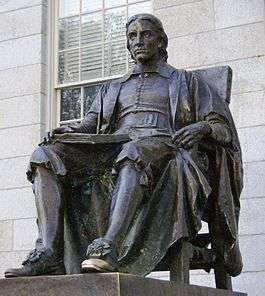Smith Campus Center
| Smith Campus Center | |
|---|---|
|
South elevation and partial east profile, 2010 | |
| Former names | Holyoke Center |
| General information | |
| Architectural style | Brutalist |
| Address | 1350 Massachusetts Avenue |
| Town or city | Cambridge, Massachusetts |
| Country | USA |
| Coordinates | 42°22′22″N 71°07′07″W / 42.37278°N 71.11861°W |
| Construction started | 1960 |
| Completed | 1966 |
| Owner | Harvard University |
| Height | 167 feet (51 m) |
| Technical details | |
| Floor count | 10 |
| Floor area | 360,000 sq ft (33,000 m2) |
| Design and construction | |
| Architect | José Luis Sert |
| Architecture firm | Sert, Jackson and Gourley[1] |
Harvard University's Smith Campus Center (formerly Holyoke Center) is a Brutalist administrative and service building occupying the block bounded by Massachusetts Avenue, Dunster Street, Holyoke Street, and Mount Auburn Street in Cambridge, Massachusetts, directly opposite the Wadsworth Gate to Harvard Yard.[1] It houses administrative offices, an infirmary of the University Health Services, and a retail/restaurant arcade.[1]
Design
Primarily designed by José Luis Sert (then dean of the Harvard Graduate School of Design) and completed in 1966, the Smith Campus Center is an H-shaped ten-story reinforced concrete building. Low-rise portions, including an underground parking garage, have a larger footprint of 360,000 square feet (33,000 m2).
After the first phase of construction in 1963, the Harvard Crimson cited a local joke: "The one nice feature about Holyoke Center is that it's the one place in Cambridge from which you can't see Holyoke Center". [2] Within a few years the building's novel design and technical features began to present numerous difficulties, which a Harvard official likened to "a five-car accident at an intersection. You just can't tell what caused it." [3] These included crumbling of exterior structural concrete and an inefficient three-pipe heating and cooling system.[3]
It was Harvard's first highrise building, and has been called a "gray elephant" for the color of its concrete facades.[4][5]
Artworks
From 1964 to 1979, the penthouse dining room was decorated with five large paintings installed by Mark Rothko, an Abstract Expressionist artist. Due to an unstable paint formulation and high levels of direct sunlight, the pigments faded severely, and the paintings were moved to protective storage. Since their removal, the artworks have been publicly displayed only five times, most recently from November 2014 to July 2015, at the newly-renovated Harvard Art Museums.[6][7]
Renaming and planned renovation
Originally known as Holyoke Center, in 2013 it was renamed the Richard A. and Susan F. Smith Campus Center. It is scheduled to undergo a "major transformation" starting in 2016, in order to provide "large, flexible indoor gathering spaces for students, faculty, and staff and include food-service, lounge, and study areas, as well as space for exhibitions, events, and performances." [8]
References
- 1 2 3 "Holyoke Center, Harvard University". DOCOMOMO US.
- ↑ "Dean Sert's Buildings". Harvard Crimson. October 8, 1963.
- 1 2 Georges, Christopher J. (November 2, 1983). "Holyoke Center Crumbles". Harvard Crimson.
- ↑ Dean, Anrea O. (January 1979). "Evaluation: 'Gray elephant' in Harvard Square: Holyoke Center, most successful of the university's first-generation highrises". AIA Journal. 68 (1): 48–51.
- ↑ Cromie, William (November 19, 1988). "UHS Celebrates A Century". Harvard Gazette.
- ↑ Sheets, Hilarie M. (23 October 2014). "A Return for Rothko's Harvard Murals". The New York Times. Retrieved 2016-07-15.
- ↑ "Exhibitions, Mark Rothko's Harvard Murals". Harvard Art Museums. Retrieved 2016-07-15.
